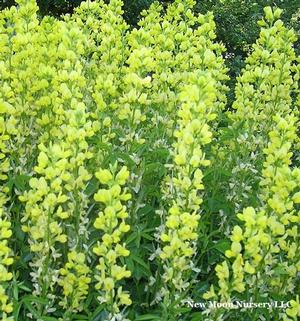New Moon Nurseries
Thermopsis villosa
Carolina lupine
Native to North America
FIRST IMPRESSIONS: Thermopsis villosa is an upright clumping perennial with bright green clover-like foliage. In early summer, plants are topped by spires of buttery yellow pea-shaped flowers. Plants thrive in sunny gardens with average well drained soils and are durable and long lived after establishment.
HABITAT & HARDINESS: Thermopsis villosa ranges from Maine to Georgia and west to Pennsylvania, Kentucky, Tennessee and Alabama. Plants are indigenous to the Appalachian Mountains of Georgia, Tennessee and North Carolina but have been introduced into other states.
This species is most likely to be found in woodland clearings, open meadows, prairies, road banks and disturbed fields.
This species is hardy from USDA Zones 4-9.
PLANT DESCRIPTION: Thermopsis villosa is an upright unbranched wildflower anchored by a sturdy taproot.
Foliage is bright green and trifoliate with three oval leaflets in each leaf. Leaflets are 2-3” long with hairy lower surfaces.
In late spring or early summer, spikey racemes of yellow florets rise above the foliage. Each floret is about ¾” long and pea-like. They evolve into flat oblong hairy pods.
Blooming plants are up to 5’ tall with 2-3’ spread.
CULTURAL & MAINTENANCE NEEDS: Thermopsis villosa grows best in full sun in well drained rich moist soil. Plants are somewhat tolerant of heat and drought and sandy or clay loam.
Young plants expend a good bit of energy producing deep tap roots. As they mature and settle in they become very difficult to successfully move.
If plants are overcrowded with poor air circulation, foliage may succumb to fungal diseases. Other than that, this is a fairly pest tolerant species that is unpalatable to deer and other herbivores.
To maintain dense growth, foliage can be cut back about a month after flowering.
LANDSCAPE USES: This is a good choice for a Wildlife Garden, Urban Landscape or Meadow. Plants are also used as Butterfly Nectar Plants, Cut Flowers or as part of a Grouping or Mass Planting. Thermopsis villosa has Showy Blooms and can be used in Cottage Gardens, Low Maintenance Plantings and Perennial Borders
COMPANION & UNDERSTUDY PLANTS: Try pairing with Aruncus dioicus, Echinacea purpurea, Penstemon digitalis, Rudbeckia hirta, Solidago speciosa, and Sorghastrum nutans.
Baptisia tinctoria has similar flowers and foliage and can be substituted if needed.
TRIVIA: Bees and butterflies seek nectar and pollen from the flowers.
Like their Baptisia spp. cousins, Thermopsis villosa is a nitrogen-fixing legume. These species have a symbiotic relationship with the Rhizobium bacteria that allows them to utilize atmospheric nitrogen.
Also known as Thermopsis caroliniana and commonly called Carolina lupine, southern lupine, Aaron's rod, Blue Ridge golden-banner, hairy false lupine or Carolina bushpea.
The common name Aaron's rod refers to the staff or stave carried by Moses's brother, Aaron, in the Torah or Old Testament. The staff is said to have magically budded. It may have looked somewhat like the slender flower racemes of Thermopsis villosa.
The generic name Thermopsis comes from Greek words meaning “Lupine like”. The specific epithet villosa means “with hairs”.
The flowers of the Legume Family (Fabaceae) have a characteristic papilionaceous or butterfly shaped flower. These pea-like flowers have five petals - a single, large, upper petal called a banner or standard, 2 smaller rounded lateral petals called wings and a pair of pointed keel shaped petals.
Height:
5 ftSpread:
2-3 ftUSDA Hardiness Zone:
4-9Bloom Color:
YellowThermopsis villosa Characteristics
Attributes
- Drought Tolerant
Exposure
- Full Sun
Deer Resistant
- Deer Resistant
Flowering Months
- July
- June
Foliage Color
- Blue-Green
Salt Tolerance
- Medium
Soil Moisture Preference
- Moist to Dry
